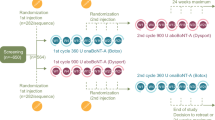Abstract
Intramuscular incobotulinumtoxinA (Xeomin®) is indicated for the treatment or improvement of adult patients with upper limb spasticity (featured indication), cervical dystonia, blepharospasm and glabellar lines. It is a highly purified formulation of botulinum toxin type A that inhibits acetylcholine signalling at neuromuscular junctions, reducing muscle hypertonia. This narrative review discusses the clinical use of incobotulinumtoxinA in adults with upper limb spasticity and summarizes its pharmacological properties. In single-treatment phase 3 trials, compared with placebo, incobotulinumtoxinA treatment improved muscle tone, global spasticity, functional spasticity-related disability and some aspects of carer burden in adults with upper limb spasticity. These beneficial effects of incobotulinumtoxinA on muscle tone were generally maintained in extension studies, in which up to five additional incobotulinumtoxinA treatments were administered. Functional spasticity-related disability and carer burden were also reduced during longer-term incobotulinumtoxinA treatment. IncobotulinumtoxinA was generally well tolerated in clinical trials, with relatively few patients experiencing treatment-related adverse events, most of which were of mild to moderate intensity. No neutralizing antibodies that would potentially cause secondary nonresponse against incobotulinumtoxinA were detected after single and multiple treatments in these trials or in phase 3 and 4 trials of incobotulinumtoxinA in other indications, which may be an advantage of this purified formulation. Further research would help to more fully determine the impact of neurotoxin purification in terms of reducing the potential risk of immunogenic responses during long-term treatment. Hence, incobotulinumtoxinA is a useful treatment option for upper limb spasticity in adult patients.
Similar content being viewed by others
References
Lance JW. What is spasticity? Lancet. 1990;335(8689):606.
Simpson DM. Clinical trials of botulinum toxin in the treatment of spasticity. Muscle Nerve. 1997;20(Suppl 6):169–75.
Esquenazi A. Improvements in healthcare and cost benefits associated with botulinum toxin treatment of spasticity and muscle overactivity. Eur J Neurol. 2006;13(Suppl 4):27–34.
Sommerfeld DK, Gripenstedt U, Welmer A-K. Spasticity after stroke: an overview of prevalence, test instruments, and treatments. Am J Phys Med Rehabil. 2012;91(9):814–20.
Bhakta BB. Management of spasticity in stroke. Br Med Bull. 2000;56(2):476–85.
Santamato A. Safety and efficacy of incobotulinumtoxinA as a potential treatment for poststroke spasticity. Neuropsychiatr Dis Treat. 2016;12:251–63.
Abbruzzese G. The medical management of spasticity. Eur J Neurol. 2002;9(Suppl 1):30–4.
Frevert J. Content of botulinum neurotoxin in Botox®/Vistabel®, Dysport®/Azzalure®, and Xeomin®/Bocouture®. Drugs R D. 2010;10(2):67–73.
Göschel H, Wohlfarth K, Frevert J, et al. Botulinum A toxin therapy: neutralizing and nonneutralizing antibodies—therapeutic consequences. Exp Neurol. 1997;147(1):96–102.
Wenzel RG. Pharmacology of botulinum neurotoxin serotype A. Am J Health Syst Pharm. 2004;61(22 Suppl 6):S5–10.
Jost WH, Benecke R, Hauschke D, et al. Clinical and pharmacological properties of incobotulinumtoxinA and its use in neurological disorders. Drug Des Devel Ther. 2015;9:1913–26.
Blümel J, Frevert J, Schwaier A. Comparative antigenicity of three preparations of botulinum neurotoxin type A in the rabbit. Neurotox Res. 2006;9(2–3):238.
Jost WH, Blümel J, Grafe S. Botulinum neurotoxin type A free of complexing proteins (Xeomin®) in focal dystonia. Drugs. 2007;67(5):669–83.
Merz Pharmaceuticals LLC. Xeomin (incobotulinumtoxinA) for injection, for intramuscular use: US prescribing information. 2015. http://www.xeomin.com/. Accessed 11 Aug 2016.
Merz Pharma UK Ltd. Xeomin 100 units: summary of product characteristics. 2014. http://www.medicines.org.uk/. Accessed 11 Aug 2016.
Dolly JO, Aoki KR. The structure and mode of action of different botulinum toxins. Eur J Neurol. 2006;13(Suppl 4):1–9.
Elovic EP, Munin MC, Kaňovský P, et al. Randomized, placebo-controlled trial of incobotulinumtoxina for upper-limb post-stroke spasticity. Muscle Nerve. 2016;53(3):415–21.
Kaňovský P, Slawek J, Denes Z, et al. Efficacy and safety of botulinum neurotoxin NT 201 in poststroke upper limb spasticity. Clin Neuropharmacol. 2009;32(5):259–65.
Elovic E, Munin MC, Kaňovský P, et al. Efficacy and safety of repeated incobotulinumtoxinA injections for upper-limb post-stroke spasticity [abstract]. In: Annual Assembly of the AAPM&R. 2015.
Kaňovský P, Slawek J, Denes Z, et al. Efficacy and safety of treatment with incobotulinum toxin A (botulinum neurotoxin type A free from complexing proteins; NT 201) in post-stroke upper limb spasticity. J Rehabil Med. 2011;43(6):486–92.
Barnes M, Schnitzler A, Medeiros L, et al. Efficacy and safety of NT 201 for upper limb spasticity of various etiologies: a randomized parallel-group study. Acta Neurol Scand. 2010;122(4):295–302.
Fiore P, Santamato A, Ranieri M, et al. Treatment of upper limb spasticity after stroke: one-year safety and efficacy of botulinum toxin type A NT201. Int J Immunopathol Pharmacol. 2012;25(Suppl 1):57S–62S.
Simpson DM, Hallett M, Ashman EJ, et al. Practice guideline update summary: botulinum neurotoxin for the treatment of blepharospasm, cervical dystonia, adult spasticity, and headache. Neurology. 2016;86:1–9.
Teasell R, Foley N, Pereira S, et al. Evidence to practice: botulinum toxin in the treatment of spasticity post stroke. Top Stroke Rehabil. 2012;19(2):115–21.
Naumann M, Boo LM, Ackerman AH, et al. Immunogenicity of botulinum toxins. J Neural Transm. 2013;120:275–90.
Acknowledgments
During the peer review process, the manufacturer of incobotulinumtoxinA was also offered an opportunity to review this article. Changes resulting from comments received were made on the basis of scientific and editorial merit.
Author information
Authors and Affiliations
Corresponding author
Ethics declarations
Funding
The preparation of this review was not supported by any external funding.
Conflict of interest
Yvette Lamb and Lesley Scott are salaried employees of Adis/Springer, are responsible for the article content and declare no relevant conflicts of interest.
Additional information
The manuscript was reviewed by: W. H. Jost, Parkinson-Klinik Wolfach, University of Freiburg, Freiburg i.Br., Germany; D. K. Sommerfeld, Department of Neurobiology, Care Sciences and Society, Division of Physiotherapy, Karolinska Institutet, Stockholm, Sweden; A. Santamato, Physical Medicine and Rehabilitation, University of Foggia, Foggia, Italy.
Rights and permissions
About this article
Cite this article
Lamb, Y.N., Scott, L.J. IncobotulinumtoxinA: A Review in Upper Limb Spasticity. Drugs 76, 1373–1379 (2016). https://doi.org/10.1007/s40265-016-0630-z
Published:
Issue Date:
DOI: https://doi.org/10.1007/s40265-016-0630-z



